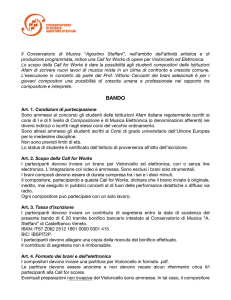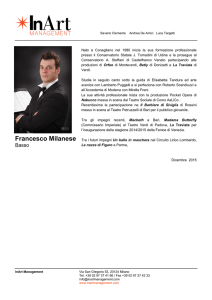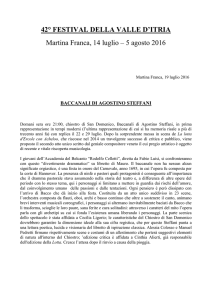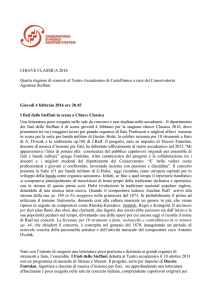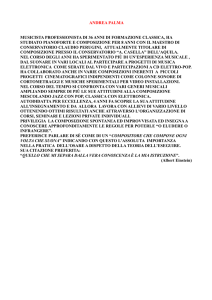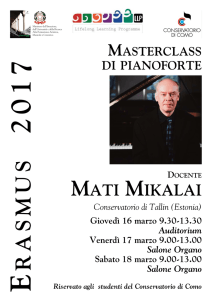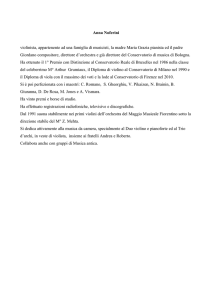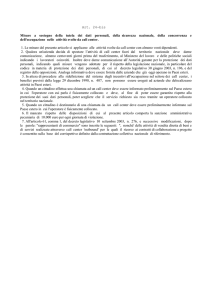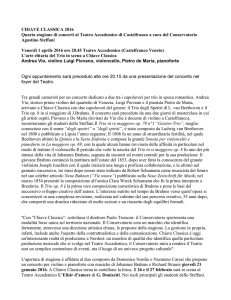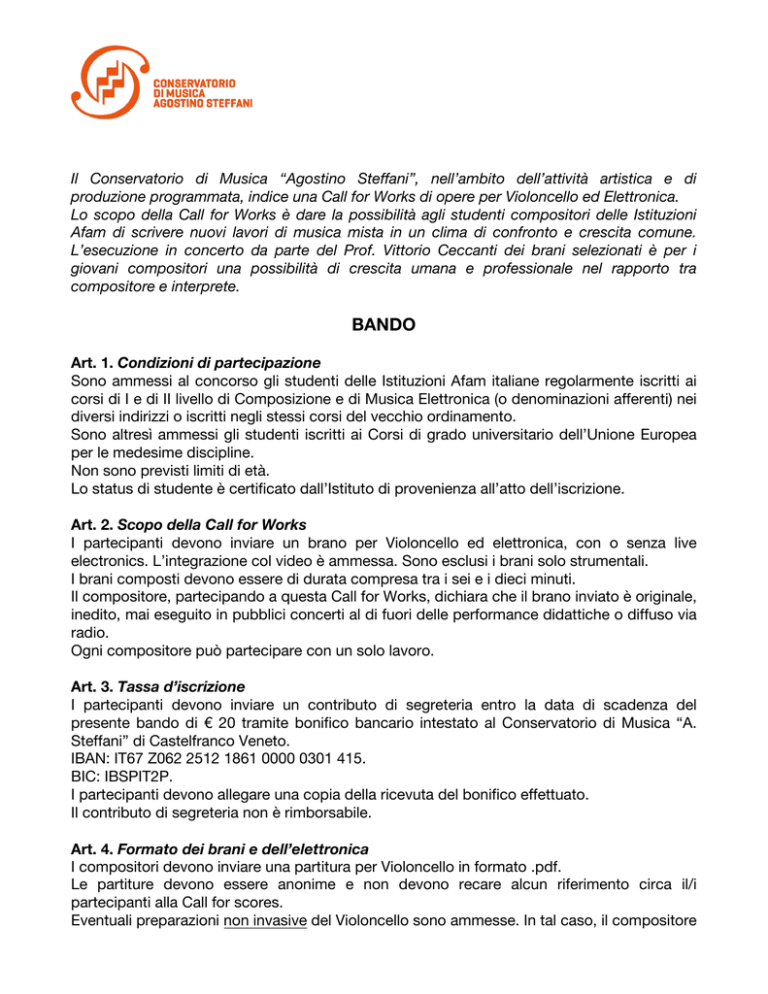
Il Conservatorio di Musica “Agostino Steffani”, nell’ambito dell’attività artistica e di
produzione programmata, indice una Call for Works di opere per Violoncello ed Elettronica.
Lo scopo della Call for Works è dare la possibilità agli studenti compositori delle Istituzioni
Afam di scrivere nuovi lavori di musica mista in un clima di confronto e crescita comune.
L’esecuzione in concerto da parte del Prof. Vittorio Ceccanti dei brani selezionati è per i
giovani compositori una possibilità di crescita umana e professionale nel rapporto tra
compositore e interprete.
BANDO
Art. 1. Condizioni di partecipazione
Sono ammessi al concorso gli studenti delle Istituzioni Afam italiane regolarmente iscritti ai
corsi di I e di II livello di Composizione e di Musica Elettronica (o denominazioni afferenti) nei
diversi indirizzi o iscritti negli stessi corsi del vecchio ordinamento.
Sono altresì ammessi gli studenti iscritti ai Corsi di grado universitario dell’Unione Europea
per le medesime discipline.
Non sono previsti limiti di età.
Lo status di studente è certificato dall’Istituto di provenienza all’atto dell’iscrizione.
Art. 2. Scopo della Call for Works I partecipanti devono inviare un brano per Violoncello ed elettronica, con o senza live
electronics. L’integrazione col video è ammessa. Sono esclusi i brani solo strumentali.
I brani composti devono essere di durata compresa tra i sei e i dieci minuti.
Il compositore, partecipando a questa Call for Works, dichiara che il brano inviato è originale,
inedito, mai eseguito in pubblici concerti al di fuori delle performance didattiche o diffuso via
radio.
Ogni compositore può partecipare con un solo lavoro.
Art. 3. Tassa d’iscrizione I partecipanti devono inviare un contributo di segreteria entro la data di scadenza del
presente bando di € 20 tramite bonifico bancario intestato al Conservatorio di Musica “A.
Steffani” di Castelfranco Veneto.
IBAN: IT67 Z062 2512 1861 0000 0301 415.
BIC: IBSPIT2P.
I partecipanti devono allegare una copia della ricevuta del bonifico effettuato.
Il contributo di segreteria non è rimborsabile.
Art. 4. Formato dei brani e dell’elettronica
I compositori devono inviare una partitura per Violoncello in formato .pdf.
Le partiture devono essere anonime e non devono recare alcun riferimento circa il/i
partecipanti alla Call for scores.
Eventuali preparazioni non invasive del Violoncello sono ammesse. In tal caso, il compositore
deve produrre un video (anche di qualità amatoriale) in cui dimostra che la preparazione del
Violoncello è possibile con materiali facilmente reperibili e che occupa un tempo inferiore ai
sessanta secondi.
Per agevolare l’espletazione del concerto, non sono possibili scordature dello strumento.
L’elettronica del brano deve essere contenuta in un patcher di Max (versione del software
6.1.9 o versione 7 più recente per computer Apple) contenuto all’interno di una cartella
insieme con tutti i file audio e dati necessari al funzionamento del patcher stesso. Eventuali
oggetti esterni alla libreria base di Max devono essere contenuti all’interno della cartella. È
possibile utilizzare gli oggetti del Forum Ircam. Eventuali dossier informatici incompleti
comportano l’automatica esclusione da questa selezione.
Il patcher di Max deve contenere un subpatcher “readme” in cui si spiega dettagliatamente
come il patcher deve essere inizializzato e usato durante l’eventuale esecuzione del brano. Il
routing dei canali di destinazione dell’audio deve essere fatto internamente al patcher senza
chiedere di modificare le impostazioni generali del software (I/O mapping della finestra DSP
status).
I microfoni prescrivibili per il live electronics possono essere:
• 2 Neumann KM 184;
• 2 Audio-Technica AT4050 (specificare il diagramma desiderato);
• 1 DPA con supporto “head set” 4066;
• 1 microfono a contatto Schertler;
• 2 Shure SM 57.
Il numero di sorgenti per il live electronics non può essere superiore a due. La posizione dei
microfoni deve essere dettagliatamente spiegata in un file di testo (.rtf, .docx o .pdf)
all’interno del dossier informatico. Non è possibile prescrivere l’uso di altri microfoni.
I dispositivi di diffusione ammessi sono:
• 2.1 (due altoparlanti sul proscenio ai lati del palco e un subwoofer);
• 5.1 (tre altoparlanti sul proscenio ai lati e al centro, due altoparlanti dietro il pubblico ai
lati della sala e un subwoofer).
La posizione del subwoofer non deve essere determinante. Il subwoofer può essere sia un
canale “somma” sia un canale attivo. Questo deve risultare dalla programmazione
informatica e non può essere delegato al cablaggio dell’impianto, nel quale il sub è un canale
indipendente.
L’uso del subwoofer è opzionale.
Per questioni d’organizzazione, non è possibile chiedere dispositivi di diffusione differenti da
quelli sopra menzionati.
Tutta la parte elettronica deve essere gestibile dalla regia. Si può prevedere l’uso di un
controller midi Behringer BCF 2000. Per semplificare la preparazione tecnica di ciascun
pezzo selezionato per il concerto, è obbligatorio usare le impostazioni di assegnazione dei
numeri di controllo Midi di default del dispositivo. L’uso di altri dispositivi di controllo Midi è
possibile ma in tal caso la presenza del compositore e la personale gestione dell’elettronica
durante il concerto è obbligatoria.
La qualità della programmazione informatica insieme con la sua resa dal vivo fanno parte dei
criteri di valutazione dei lavori.
Art. 5. Formato del video
È ammesso l’uso del video. Sono ammessi tutti i tipi di soggetti video. E’ esclusa la
proiezione di prodotti commerciali, loghi commerciali, spot pubblicitari e quanto altro non
inerente all’opera in concorso.
I file video in tempo differito devono essere inviati in formato .mov 1080p e possono essere
lanciati tramite QuickTime esternamente al software per l’elettronica. Il compositore
indicherà espressamente nel file “readme” contenuto nel patcher di Max quando il lancio del
video interviene durante il pezzo. Il file video può anche essere contenuto all’interno del
dossier informatico per essere lanciato con comandi all’interno del patcher di Max. I video
utilizzati devono essere liberi da diritti fissi d’utilizzazione.
L’elaborazione video in tempo reale è altresì ammessa. Questa deve essere
obbligatoriamente realizzata all’interno del software Max e deve essere contenuta nello
stesso patcher per la gestione dell’audio.
In luogo del concerto, si proietteranno i video come retro-proiezione. Il violoncellista sarà a
lato del video.
Art. 5. Presenza dei partecipanti selezionati al concerto finale
La presenza dei compositori durante il concerto finale per l’esecuzione della parte elettronica
del loro brano non è obbligatoria.
Le spese di viaggio, vitto e alloggio sono a carico dei partecipanti. Nel caso in cui i
compositori non siano presenti, l’elettronica sarà gestita dai docenti di Musica Elettronica del
Conservatorio di Musica “A. Steffani” di Castelfranco Veneto.
Art. 6. Gruppi di lavoro
Le collaborazioni tra compositori sono ammesse. I team di lavoro, durante la selezione,
valgono come un candidato singolo.
Nell’invio della candidatura devono essere esplicitamente menzionati i ruoli (composizione
strumentale, realizzazione dell’elettronica, realizzazione del video, ecc.).
Art. 7. Commissione di valutazione
I brani pervenuti entro i termini del presente bando saranno preliminarmente valutati sulla
base delle partiture ricevute. Le partiture saranno consegnate ai giurati in forma anonima.
Si selezioneranno al massimo sei brani che saranno suonati dal Prof. Vittorio Ceccanti,
docente presso il Conservatorio di Musica “A. Steffani”, in un concerto pubblico che si terrà
a Castelfranco Veneto il 19 ottobre 2016 (le prove con l’elettronica saranno il 18 ottobre). Il
Conservatorio di Musica “A. Steffani” si riserva di modificare la data del concerto e delle
prove per cause di forza maggiore; in tal caso, gli interessati saranno informati
tempestivamente. La Commissione per la valutazione preliminare e per quella dei brani
eseguiti nel concerto di premiazione sarà composta da docenti del Conservatorio di Musica
“A. Steffani” e dal Prof. Marco Momi docente presso il Conservatorio “F. Morlacchi ” di
Perugia.
I docenti di Musica Elettronica del Conservatorio “A. Steffani” non faranno parte di questa
commissione.
I giudizi delle commissioni sono insindacabili e inappellabili.
Art. 8. Modalità d’invio dei dossier e scadenza del bando
I dossier con i lavori, completi in ogni loro parte devono arrivare tramite internet (allegato di
posta elettronica, link dropbox, wetransfer, link a uno spazio ftp, ecc.) entro il 9 settembre
2017 alle ore 15.00 all’indirizzo mail PEO [email protected] o PEC
[email protected].
L’invio di dossier incompleti è motivo di esclusione dalla Call for Works.
I compositori s’impegnano a fornire tutti i materiali informatici, audio e video necessari per la
corretta diffusione del pezzo nei tempi stabiliti da questo bando.
Art. 9. Premi
Ai compositori selezionati per il concerto finale sarà rilasciato un attestato di partecipazione.
La commissione che assisterà al concerto finale attribuirà una borsa di studio di € 500 (al
lordo delle ritenute di legge) al compositore o al gruppo di lavoro ritenuto migliore. Nel caso
in cui l’assegnatario sia uno studente non iscritto presso il Conservatorio di Musica “A.
Steffani”, tale borsa di studio sarà versata all’Istituzione di appartenenza, la quale
provvederà al versamento in solido.
La Commissione potrà attribuire delle Menzioni di Merito qualora lo ritenga necessario.
Art. 10. Liberatoria
Gli studenti devono allegare, unitamente alla scheda d’iscrizione e tutti i materiali necessari
alla partecipazione a questa Call for Works una liberatoria all’utilizzo dei brani selezionati per
le finalità indicate dal presente bando.
Art. 11. Informazioni aggiuntive
Per ogni informazione aggiuntiva, si prega di contattare l’ufficio produzione del
Conservatorio: [email protected].
Art. 12. Disposizioni finali
Nel caso di lavori collettivi, le ripartizioni dei diritti non riguardano la presente Call for Works.
Per ogni eventuale controversia, fa fede la versione italiana del presente bando, vale la
Legge italiana ed è competente il foro di Treviso.
Per quanto non espressamente previsto dal seguente bando di concorso, valgono le
disposizioni del Codice Civile italiano e delle leggi speciali in materia.
Il bando e la scheda d’iscrizione sono altresì scaricabili dal sito conscfv.it.
In the area of artistic activity and planned production, the “Agostini Steffani” Conservatoire of
Music has established a Call for Works of compositions for Cello and Electronics.
The aim of this Call for works is to give composition students in Afam institutions the
possibility of writing new works of combined music in a climate of comparison and common
growth. The concert performance by Professor Vittorio Ceccanti of the pieces selected will
also provide young students with the opportunity of personal and professional development
in the relationship between composer and interpreter.
COMPETITION ANNOUNCEMENT
Art. 1. Conditions of participation
Competition admission is limited to students officially enrolled in 1st and 2nd levels of
Composition and Electronic Music (or equivalent denomination) in diverse subject areas or
enrolled in equivalent courses in the traditional conservatoire curriculum.
Students enrolled in European Union university courses of the same subjects are also eligible
for admission.
There is no age limit.
Student status is certified by the institute of origin at the moment of registration.
Art. 2. Call for works procedure of registration
Participants must send a piece for cello and electronics, with or without ‘live electronics’.
Integration of video material is permitted. Pieces entirely instrumental are not accepted.
The pieces submitted must have a duration of between six and ten minutes.
The composer participating in Call for works must declare that the piece submitted is
original, unpublished, that it has never been transmitted via radio or played in public with the
exception of didactic performances.
Each composer can submit one piece only.
Art. 3. Registration fee
Participants must send the registration fee of €20 before the competition announcement’s
deadline, through the following bank transfer in the name of “A. Steffani” Conservatoire of
Music, Castelfranco Veneto.
IBAN: IT67 Z062 2512 1861 0000 0301 415
BIC: IBSPIT2P
Participants must attach a copy of the receipt of the bank transfer carried out.
Art. 4. Format of registration
Composers must send a score for cello in .pdf format.
Scores must be anonymous and must not contain any references concerning participants in
‘Call for Works’.
Contingent limited modifications to the cello are permitted, in which case the composer must
provide a video (even if of amateur quality) which demonstrates the cello’s preparation –
using easily available materials – within a time limit of sixty seconds.
To facilitate the performance during the concert, eventual scordature will not be permitted.
The electronic part of the piece must be contained in a Max patcher (software version 6.1.9
or the more recent version 7 for Apple computer) in a folder together with all the audio files
and necessary data for the operation of the patcher itself. Additional objects outside of the
Max data library must be contained in the folder. The use of Forum Ircam objects is
permitted. Incomplete informatics dossiers will lead to the automatic exclusion in the
selection procedure.
The Max patcher must contain a “readme” subpatcher which explains in detail how the
patcher must be initialized and used during a eventual performance of the piece in question.
The routing of the sound’s destination channels must be made inside the patcher without
necessitating the modification of the software’s general set up (I/O mapping of the window
DSP status).
The prescribed microphones for the live electronics can be:
• 2 Neumann KM 184;
• 2 Audio-Technica AT4050 (specifying the necessary diagram);
• 1 DPA with “head set” 4066 support;
• 1 Schertier contact microphone;
• 2 Shure SM 57.
The number of sources for the live electronics must not exceed two. The positioning of the
microphones must be explained in detail in a text file (.rtf, .docx o .pdf) inserted in the
informatics dossier. The use of additional microphones is not permitted.
Permitted diffusion devices are:
• 2.1 (two speakers to the sides of the stage and a subwoofer);
• 5.1 (three speakers to the sides of the stage and in the centre, two speakers behind
the audience to the sides of the hall and a subwoofer).
The positioning of the subwoofer must not be determinant. The subwoofer can be both a
sum and a live channel. This must be clear from the informatics programing and cannot be
delegated to the cabling system in which the sub is an independent channel.
The use of the subwoofer is optional.
For organisational reasons, it is not possible to request diffusion devices different from those
mentioned above.
The entire electronic part must be managed by the direction. The use of a Midi controller
Behringer BCF 2000 is available. To simplify the technical preparation of each of the pieces
selected for the concert, it is obligatory to use the assignment settings of the predefined Midi
controller numbers. The use of other Midi controller devices is possible but in such a case
the presence of the composer and the personal management of the electronics during the
concert is mandatory.
The quality of the informatics planning, together with the outcome in live performance, will be
part of the evaluation criteria applied to the works in question.
Art.5. Video format
Video use is permitted. All types of video subjects are permissible. However, the projection
of commercial products and brand names, adverts and other items not inherent to the
competition are prohibited.
The video file in deferred time must be sent in .mov 1080p format and can be activated
through QuickTime external to the electronics software. The composer must indicate in the
“readme” file contained in the Max patcher exactly when the video must be activated during
the piece. The video file can also be inserted in the informatics dossier so that it can be
activated through instructions within the Max patcher. All videos must be free of copyright
restrictions.
The elaboration of a real time video is also permitted. This must be implemented within the
Max software and must be contained in the same patcher as the sound management.
During the concert, the video will be back-projected. The cellist will be to one side of the
video.
Art. 5. Presence of participants at the final concert
The presence of composers for the performance of the electronic part of their pieces during
the final concert is not obligatory.
Travel expenses and board and lodging will be met by participants. In the event of the
composer’s absence, the electronics will be managed by lecturers in Electronic Music of the
“A. Steffani” Conservatoire, Castelfranco Veneto.
Art. 6. Work groups
Collaboration between composers is permitted. Work teams will be evaluated as a single
candidate during the selection.
In the candidacy presentation, individual roles must be explicitly mentioned (instrumental
composition, management of electronics, video etc.).
Art. 7. Evaluation commission
Compositions that arrive within the terms of the present announcement will be preliminarily
assessed on the basis of scores received. The scores in question will be consigned
anonymously to the commission members.
A maximum of six pieces will be selected and performed by Vittorio Ceccanti, professor of
cello at the “A. Steffani” Conservatoire of Music, in a public concert held on the 19th October
2017 in Castelfranco Veneto (the rehearsals with the electronic parts will take place on the
18th October). The “A. Steffani” Conservatoire of Music reserves the right to modify the
concert and rehearsal dates in case of circumstances beyond its control; in which case, all
concerned will be immediately informed. The preliminary Evaluation Commission and the
Commission at the final concert will be composed of lecturers from the “A. Steffani”
Conservatoire of Music and Prof. Marco Momi, lecturer at the “F. Morlacchi” Conservatoire,
Perugia.
Lecturers in Electronic Music at the “A. Steffani” Conservatoire of Music will not be taking
part in this commission.
The judgements of commissions are final and not subject to appeal.
Art. 8.
The work dossiers must be complete in every part and must arrive through the internet (as an
email attachment, dropbox link, wetransfer, ftp link etc.) by 15.00 hours, 9th September 2017,
at one of the following email addresses: PEO [email protected] or PEC
[email protected] .
The sending of an incomplete dossier will result in the exclusion from the Call for Works
competition.
Composers must provide all the informatics materials, including audio and video materials,
necessary for a correct diffusion of the piece in the time stipulated by this competition
announcement.
Art. 9. Awards
Composers selected for the final concert will receive a certificate of attendance. The
Evaluation Commission present at the final concert will award a scholarship of €500 (taxinclusive) to the composer or work group that it considers to be the best. In the case in
which the award winner is a student not enrolled at the “A. Steffani” Conservatoire of Music,
the scholarship sum will be forwarded to his or her Institution, which will then be responsible
for the payment.
The Commission also has the power to confer the Mention of Honour if deemed appropriate.
Art. 10.
Together with the registration form and all the necessary materials for participating in this
Call for Works, students must attach a release declaration for the utilization of the pieces
selected in regards to the aims indicated in this announcement.
Art. 11. Further information
Further information can be obtained by contacting the Conservatoire’s production office:
[email protected] .
Art. 12. Final provisions
In the event of collective compositions, the rights allocations do not concern this Call for
Works. For any dispute, the Italian version of this announcement prevails and, according to
Italian law, the issue will be submitted to the exclusive jurisdiction of the Court of Treviso.
Concerning issues not foreseen in this competition announcement, provisions of the Italian
Civil Code will be applied as well as special laws in the field in question.
The announcement and the registration form are also available in the internet site conscfv.it .
CALL FOR WORKS
VIOLONCELLO ED ELETTRONICA
DOMANDA DI ISCRIZIONE
(si prega di scrivere in stampatello, far timbrare l’Istituzione di appartenenza,
scannerizzare e inviare a mezzo posta elettronica insieme con il dossier di partecipazione)
Nome
Cognome
Luogo e data di nascita
Cittadinanza
Recapito postale
Telefono
Email
◊
Studente iscritto al (indicare la denominazione del corso)
.............................................................................
del Conservatorio di . . . . . . . . . . . . . . . . . . . . . . . . . . . . . . . . . . . . . . . . . . . . . . . . . . . . . . . . . . .
Titolo del brano: . . . . . . . . . . . . . . . . . . . . . . . . . . . . . . . . . . . . . . . . . . . . . . . . . . . . . . . . . . . . . . .
Setup: . . . . . . . . . . . . . . . . . . . . . . . . . . . . . . . . . . . . . . . . . . . . . . . . . . . . . . . . . . . . . . . . . . . .
Durata: . . . . . . . . . . . . . . . . . . . . . . . . . . . . . . . . . . . . . . . . . . . . . . . . . . . . . . . . . . . . . . . . . . . . . .
Timbro dell’Istituzione di appartenenza
(a confermare l’iscrizione durante l’A.A. corrente)
Data, luogo
In fede
CALL FOR WORKS
CELLO AND ELECTRONICS
REGISTRATION FORM
(please write in block letters, have the form stamped by your institution,
scan and send by electronic post together with the dossier of participation)
Name
Surname
Place and date of birth
Citizenship
Postal address
Telephone
Email
◊
Student enrolled in (write the denomination of the course)
.............................................................................
of the Institution . . . . . . . . . . . . . . . . . . . . . . . . . . . . . . . . . . . . . . . . . . . . . . . . . . . . . . . . . . . . . . . . .
Title of the piece: . . . . . . . . . . . . . . . . . . . . . . . . . . . . . . . . . . . . . . . . . . . . . . . . . . . . . . . . . . . . . . .
Setup: . . . . . . . . . . . . . . . . . . . . . . . . . . . . . . . . . . . . . . . . . . . . . . . . . . . . . . . . . . . . . . . . . . . .
Duration: . . . . . . . . . . . . . . . . . . . . . . . . . . . . . . . . . . . . . . . . . . . . . . . . . . . . . . . . . . . . . . . . . . . . . .
Stamp of your Institution
(to confirm the registration during the present A.A.)
Date, place
Yours faithfully

